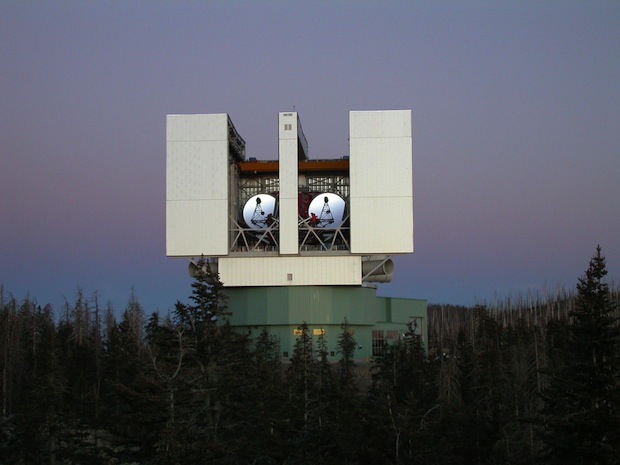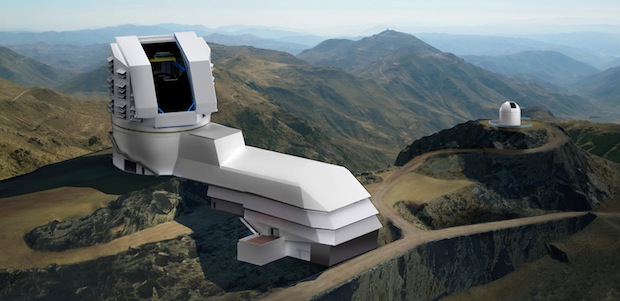Bold New Views of Our Universe
Under the leadership of former Research Corporation President John P. Schaefer, the Foundation has played key roles in the origination of two distinct projects expected to greatly advance modern astronomy -- the Large Binocular Telescope (LBT) currently operating atop Mount Graham in southeastern Arizona; and the Large Synoptic Survey Telescope (LSST), planned for Chile’s El Peñón peak on Cerro Pachón.
Both projects reflect Dr. Schaefer’s fundamental attitude toward RCSA and its mission. He has said: “Our founder, Frederic Gardner Cottrell, and most of the individuals who have worked for and on behalf of RCSA over the years, have consistently maintained that we should strive to do things that make a difference. The Foundation ought to do things that are bold and worthwhile.”

Large Binocular Telescope
With its twin 8.4-meter mirrors spanning 23-meters from edge to edge, the LBT is the world’s largest and most technologically advanced optical/infrared telescope on a single mount. With its unique optical design as a binocular telescope with adaptive-optic secondary mirrors, the LBT produces images with better resolution than the Hubble space telescope. Using its specially designed high-tech cameras, spectrometers, and interferometers allows astronomers to view objects and events not previously accessible.
The LBT has made previously impossible discoveries about extrasolar planets and provided astronomers with new insights into how stars are formed.
The massive instrument’s innovative mirrors were designed and constructed by Kavli Prize laureate and MacArthur Foundation “genius grant” recipient Roger Angel, a University of Arizona professor. Angel received his first funding from Research Corporation at age 28.
“It was RCSA’s timely intervention at an early stage of the project that enabled the LBT to be built,” observes RCSA Board President Patrick S. Osmer, a noted astronomer who is Vice Provost for Graduate Studies and Dean of the Graduate School of The Ohio State University. In 1992 RCSA organized and became a partner in the international consortium that built the LBT. The consortium includes roughly a dozen major research universities in the U.S. and Europe.
Since achieving first light October 12, 2005, the LBT has demonstrated the best-in-the-world performance in canceling the blur of the Earth’s atmosphere. By supporting the high risk, high payoff development of the LBT, RCSA has truly made a difference in the field of astrophysics. Learn more in general: Large Binocular Telescope . Or: LBT Latest Developments.

Large Synoptic Survey Telescope
Currently one of the National Science Foundation’s top funding priorities, the 8.4-meter LSST will survey the entire visible sky deeply in multiple colors every week with its three-billion pixel digital camera. The instrument is designed to probe the mysteries of Dark Matter and Dark Energy, and open a movie-like window on exploding supernovae, potentially hazardous near-Earth asteroids, and distant Kuiper Belt Objects.
During its first few years of operation, it is predicted, the LSST will be able to locate amazing numbers of football field-sized threats to our planet -- roughly 90% of all potentially hazardous asteroids and more than 50% of all near earth objects.
Plans for sharing the data from LSST with the public are as ambitious as the telescope itself. Anyone with a computer will be able to fly through the Universe, zooming past objects a hundred million times fainter than can be observed with the unaided eye. The LSST project will provide the tools to enable both students and the public to participate in scientific discovery. In 2003 RCSA’s Dr. John Schaefer created a nonprofit corporation to manage the collaboration of more than 100 scientists and engineers, and to raise funds for construction of the LSST. Learn more: Large Synoptic Survey Telescope




